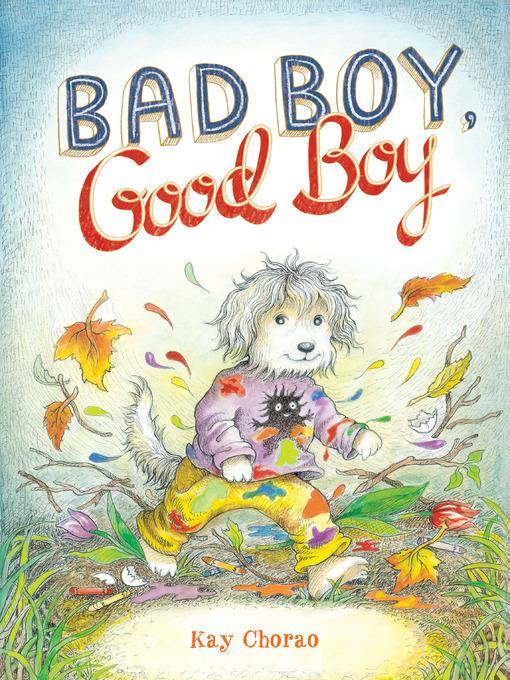
Bad Boy, Good Boy
فرمت کتاب
ebook
تاریخ انتشار
2013
Lexile Score
390
Reading Level
0-2
ATOS
1.7
Interest Level
K-3(LG)
نویسنده
Kay Choraoناشر
ABRAMSشابک
9781613125052
کتاب های مرتبط
- اطلاعات
- نقد و بررسی
- دیدگاه کاربران
نقد و بررسی

March 18, 2013
Chorao (All the Seasons of the Year) introduces an anthropomorphic puppy with a big heart and a nose for trouble in this uneven collection of four tales. Even when Sam is being “bad,” his intentions are anything but. He disrupts his grandparents’ and parents’ activities—apologizing each time—as he barrels through the yard to retrieve his friend Olive’s lost hat. In other stories, Sam agrees to help his discombobulated Grandpa put together a midnight snack, makes a mess with paints in the classroom, and sneaks outdoors to rescue a bird that has fallen from its nest. Chorao sometimes keeps readers in the dark about Sam’s motivations, later revealing the “good” behind his “bad” actions. Children aren’t likely to mind that, but they may be troubled by how often Sam’s family and friends angrily call him a “bad boy”—Sam may be slovenly, careless, and unpredictable, but the adults in his life frequently come across as callous or even verbally abusive. Chorao’s visual storytelling is strong—her watercolor, gouache, and black pen panel illustrations are suggestive of a graphic novel for youngest readers—but the underlying story disappoints. Ages 5–8.

April 15, 2013
The tale of a young pup whose good deeds only appear naughty falls flat due to the repeated use of judgmental phrases in speech bubbles. In four brief chapters, young readers meet Sam, an exuberant, somewhat impulsive pup whose heart is in the right place. While he does run amok through the grown-ups' activities ("Bad boy!") on the way to finding a friend's lost hat ("Good boy!"), he is very careful not to make the same mistakes upon his return, though the adults don't notice. When banned-from-cooking Sam helps blind-without-his-glasses Grandpa with his midnight snack, the large cartoon panels show Mama's progression from anger to understanding. Some quite accidental mishaps at school provoke his teacher to call him a "Bad boy!" and send him to the corner, where he purposefully starts trouble and, confusingly, is dubbed a creative "Good boy!" In the final chapter, Sam slips out unseen during a storm; his frantic relatives find him sheltering a fallen baby bird. Watercolor, gouache and pen illustrations show anthropomorphized dogs whose expressions speak volumes, especially the angry and fearful ones. Unlike Chorao's Kate (Up and Down with Kate, 2001), Sam doesn't face everyday situations, so readers may find it difficult to relate...unless they often hear the titular phrases. What is most worrisome is that even when the grown-ups seem to recognize that Sam is trying his best to do the right thing, they don't see that he learns from his mistakes and is a good boy indeed. Readers will be left saying, "Poor Sam," after this one. (Picture book. 4-8)
COPYRIGHT(2013) Kirkus Reviews, ALL RIGHTS RESERVED.

May 1, 2013
PreS-Gr 2-Poor Sam always seems to be in trouble due to an excess of joie de vivre. He disturbs his family while pretending to be the wind but finds his best friend's hat. He disappears in the middle of a stormy day only to be found sitting in a big nest he built to protect a baby bird who had fallen from a tree. Chorao shows that youngsters can have two sides to their personalities through her colorful, amusing pictures. When he is awakened by a nighttime noise, Sam sneaks downstairs to find Grandpa making a mess in the kitchen. Hindered by his lack of glasses, Grandpa needs help making chocolate eggs and toast along with a huge mess, ultimately getting Sam into trouble. Sam explains all to Mom and Grandpa thanks him for helping. The animal characters have comical expressions and a great sense of movement. Chorao makes some enjoyably interesting choices in breaking up pages into comic-book panels, adding to the overall visual appeal. Kids will certainly relate to Sam, whose intentions are always good even if he sometimes causes a commotion.-B. Allison Gray, Goleta Public Library, CA
Copyright 2013 School Library Journal, LLC Used with permission.

May 1, 2013
Grades K-2 Four vignettes depict high-spirited puppy Sam as he tries desperately to be goodand often falls short. In Found he careens into his entire family and destroys Grandma's tulips en route to retrieving friend Olive's runaway hat. He disobeys Mama's no-cooking rule in Snack to help his sight-impaired grandpa prepare a midnight snack. In Leaves, Sam displays his creativity by painting in the corner after he has trouble coloring inside the lines. And in Nest he ventures outside in a rainstorm to build a nest for a homeless bird. In each story, Chorao withholds Sam's true motivations until the end, making others' harsh judgments ( Bad boy! ) understandable. It's reassuring that they always correct and praise ( Good boy! ) once Sam's heart of gold is revealed. Chorao's signature watercolor, gouache, and ink illustrations depict all the characters as dogs with human attributes and emotions. Pair this with Cari Best's Are You Going to Be Good? (2005) or Mark Teague's Dear Mrs. LaRue: Letters from Obedience School (2002) for other perspectives on good behavior.(Reprinted with permission of Booklist, copyright 2013, American Library Association.)

























دیدگاه کاربران